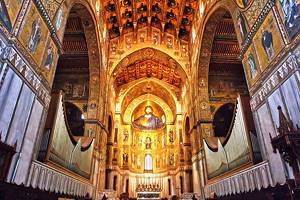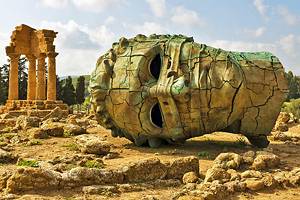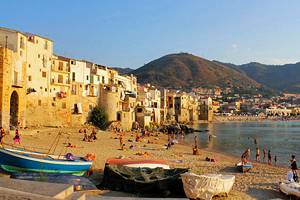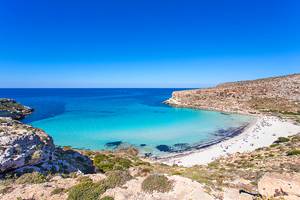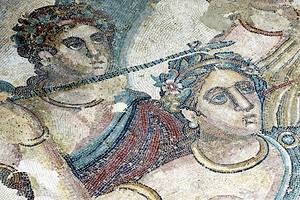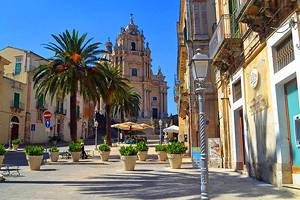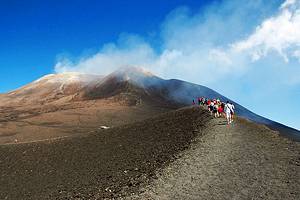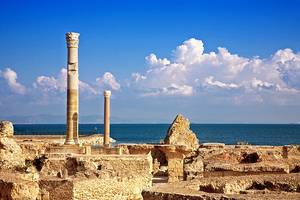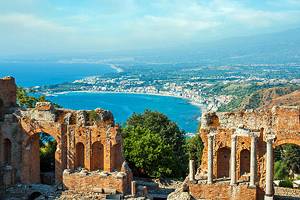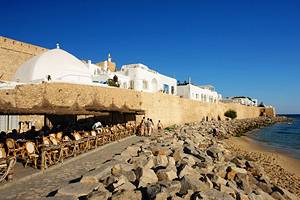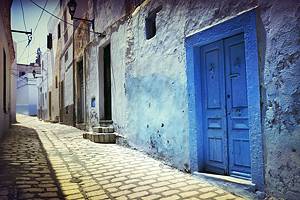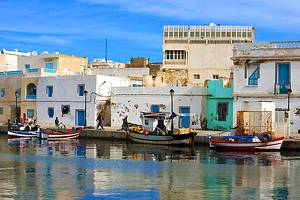Popular Tourist Attractions in Trapani
Beautifully set on a promontory at the foot of Monte Erice in northwest Sicily, Trapani is a lively and historic port. The Carthaginians made it into a naval port at the beginning of the First Punic War in 260 BC, but it was soon taken by the Romans, under whose rule it languished in obscurity until the 9th century AD, when it thrived again under the Saracene.
Trade and commerce prospered under the Normans, too, as well as under the Aragonese in the 15th century, when the great salt fields were laid out. In contrast with the narrow streets of the old town, Trapani's new town to the east is one of broad public spaces. Piazza Vittorio Emanuele looks down onto lawns, and the adjacent tree-shaded park of the Villa Margherita, which is used as one of the locations for the Luglio Trapanese musical festival, held each July.
Discover things to see and do in this vibrant Sicilian city with our list of the attractions in Trapani.
Saline di Trapani e Paceco (Saltworks)

In front of Trapani's town gates lie giant salt fields, with the windmills that have become an icon of this part of Sicily's coast. Salt production began in the 15th century under the Aragonese, who laid out these salt fields that were to become Trapani's main industry for several centuries.
The white heaps of salt are covered with tiles to prevent the salt from blowing away and to keep it dry. Salt production today is on a much smaller scale than it was at its height from the 16th to early-20th centuries, but the fields and windmills are a haven for photographers, especially when their sails are silhouetted against an orange sunset. A museum explains their workings with old tools and signage that bring the fields to life.
Old Town & Harbor

Trapani's Old Town lies to the west of Piazza Umberto and the rail station, beginning where Via XXX Gennaio runs from north to south and filling the narrow peninsula; Corso Italia and Corso Vittorio Emanuele traverse it from east to west.
In the 9th century, under the Saracen rule, the widest part of the peninsula between Via XXX Gennaio and Via Torre Arsa was the Arab Quarter, where both Arabs and Jews lived. In the lively and atmospheric lanes and alleys of the Old Town, you'll find plenty of small shops and places to eat.
When walking through Trapani's Old Town, you'll get a glimpse every now and then of the blue sea that surrounds the peninsula to the north and the south. To the south lies the harbor and Piazza Garibaldi, with its shipping offices and departure wharves for ships and hydrofoils going to the Egadi Islands, and Viale Regina Elena, with views of the saltworks and the Egadi Islands.

Ligny Tower & La Colombaia

At the end of the pier on the far western tip of the town stands the low, square Torre di Ligny. This 14th-century defensive tower was extended in the 16th century and finally in 1670 under the viceroy Prince of Ligny. During World War II, it was armed and served as a Naval anti-aircraft post.
Today it is a symbol of the city and houses the Museum of Prehistory, with a marine archaeological exhibition hall and prehistoric artifacts from the Mangiapane caves. The views over the Sicilian Channel and the Tyrrhenian Sea are worth the walk along the point, and it is the best place in Trapani to watch the sunset.
Off the harbor entrance on this southern side is the island of La Colombaia, with the fortifications and octagonal Torre Colombaia, also known as the Castello di Mare. In the fifteenth century, it was used as a fortress and then as a prison.
Address: Via Torre di Ligny, Trapani
Cattedrale di San Lorenzo

The church of San Lorenzo, which did not become a cathedral until 1844, was built in 1421, and restructured in 1635 as a triple-aisled basilica that was once again redesigned and extended by Giovan Biagio Amico in 1740.
Amico is responsible for a number of Trapani's churches, so you'll hear his name again. He built the side chapels and choir, and added the portico and the dome, which is flanked by four towers. The stucco work in Neoclassical-style was done at this time, as were the frescoes by Vincenzo Manno.
Artworks in the cathedral include a sculpture of The Dead Christ in local stone by Giacomo Tartaglia, the Eternal Father by Domenico La Bruna, and San Giorgio by Andrea Carreca, but the unquestioned treasure is a painting of the Crucifixion attributed to the Flemish painter Van Dyke.
Address: Via Generale Giglio Domenico, Trapani
Museo Regionale Pepoli
The Carmelite abbey adjoining the Santuario di Maria SS di Trapani, secularized in 1866, has a beautiful cloister dating from 1650 and a wide stairwell from 1639. It now houses the Museo Regionale Pepoli, displaying medieval architectural fragments and sculptures on the ground floor, including a 1522 statue of San Giacomo by Antonello Gagini.
A wide staircase leads to the upper floor, where the Pinacotheca includes works by Titian, Paolo Veronese, Ribera, and Serpotta. Other galleries display archaeological finds and local crafts, including coral jewelry.
Address: Via Conte Agostino Pepoli, Trapani
Museum of Illusions
Challenging the notion that seeing is believing, the Museum of Illusions makes you wonder if you can actually trust what you see. Using art, architecture, physics, optics and a bit of psychology, the interactive exhibits make visitors doubt their own perceptions.
Galleries show how art can be used to fool the eye and mind (think of M.C. Escher), while innovative participatory spaces create illusions that appear to defy gravity. You may see fellow visitors appear to walk up walls or stand at impossible angles, but it's just your brain playing tricks on you.
Although the information panels are all in both Italian and English, a guided tour (available in English) is necessary in order to get the full effect of the optical illusions. If you need a break from churches, palaces, and ancient ruins, this museum is the right place to visit.
Address: Via Mercè 2, Trapani, Italy
Official site: https://www.mooitrapani.com/
Chiesa del Collegio

The Jesuit church in Trapani was designed by the Sicilian monk and master-builder Natale Masuccio and built between 1606 and 1638. The façade was designed by Francesco Bonamici and is highly decorated with Baroque volutes, statues, and a central window.
The three aisles are separated by pillars, and a vaulted roof and a dome rises above the chancel. The high altar is decorated with a marble relief of the Immaculata by Ignazio Marabitti (1766), and the stucco work on the walls is by Bartolomeo Sanseverino.
In the 18th century, G.B. Amico built the Sant'Ignazio Chapel to the left of the apse. Look especially for the wooden wardrobe in the sacristy by Pietro Orlando; a wooden crucifix by Giuseppe Milanti; and the painting, San Francesco Saverio, by Pietro Novelli.
Address: Corso Vittorio Emanuele, Trapani
Santuario dell'Annunziata

The pilgrimage church of the Virgin Mary, also called the Santuario di Maria SS di Trapani, was founded as a Carmelite chapel in the 13th century, but was almost immediately replaced by a large church. The facade, with its richly decorated door and rose window, was preserved from that 14th-century church when the building was completely renovated in 1742 by G.B. Amico.
Amico created a vaulted church with an oval dome above the chancel. Richly decorated chapels line the single aisle. The Fishermen's Chapel (Cappella dei Pescatori) is from the 15th century in the Late Gothic style with an octagonal dome and 16th-century frescoes; the domed Seamen's Chapel (Cappella dei Marinai) is from 1514-40.
The Cappella della Madonna, in the choir behind the high altar, was begun in 1498 to house the statue of the Madonna of Trapani that arrived from Cyprus in 1188 and is the most revered and most copied one in Sicily. Sculpted about 1350 by Nino Pisano or his school, the image is carried in the Good Friday procession.
In the 16th century, this chapel was given a marble entrance arch by Antonello Gagini and his sons, and it was blocked off with a bronze grille in 1591.
Santa Maria dell'Itria

The present church and convent were built on the site of a church dedicated to Santa Maria dell'Itria, which was turned over to the Augustinian Fathers in 1621 to build an oratory for the confraternity of Santa Maria dell'Itria.
The façade was completed in 1745 by Pietro Castro, with Corinthian columns and niches that once held statues. Directly above the entrance door is a deeply carved relief. Inside are paintings by Pietro Novelli, Andrea Carreca, and Giuseppe De Felice, but perhaps the most interesting and unusual work of art in the church is on the main altar. Here, you'll find the Holy Family portrayed in a set of sculptures made of wood, canvas, and glue by Andrea Tipa.
Address: Via Garibaldi, Trapani
Santa Maria del Gesù
Follow Corso Italia west to find Via Elisabetta on the left, and the former Franciscan church of Santa Maria del Gesù, built after 1528 in the late medieval style. Inside, in the Cappella Staiti, under a 1521 marble canopy by Antonello Gagini, you can see a terra-cotta Madonna, thought to be by the great Florentine terra-cotta master, Andrea della Robbia.
Also worth noting are the paintings of San Diego and the Porziuncola by D. La Bruna, and San Domenico and San Francesco by V. Carreca.
Address: Via Elisabetta, Trapani
Palazzo Cavarretta

Don Giacomo Cavarretta commissioned building his palazzo to the architect Andrea Palma in 1672. Since its construction, Palazzo Cavarretta has been modified several times, but has retained its stunning façade, which forms a dramatic finale to Corso Vittorio Emanuele.
At the top are statues of the Madonna of Trapani, St. John the Baptist, and St. Albert, created in 1700 by Giuseppe Nolf. About a century later, these were flanked by a clock and calendar. Having served for a time as the meeting place of the senate, it is now the municipal building. Corso Vittorio Emanuele has several impressive palace facades lining it and framing the view of Palazzo Cavarretta.
Address: Via Torrearsa, Trapani
Sant'Agostino

Built as the Chapel of the Knights Templar in 1101, this church was given to the Augustinian order in the 14th century and was restructured and enlarged, adding the current façade, a large rose window, and a polygonal apse. It was modified again in the 19th century, when it was deconsecrated as a church.
The former church is now predominantly used as a cultural venue, hosting the Polo Espositivo della Diocesi di Trapani (an exhibition space for the Diocesan Museum) and other events and concerts.
The apse and part of the nave of Sant'Agostino were destroyed in the Second World War, and the church was again rebuilt. The door and the extraordinarily beautiful rose window from the old church were saved, and this west front looks out onto the Piazza Saturno. The square is named after the 16th-century Fountain of Saturn, which refers to the myth of Trapani's founding.
Address: Piazza Sant'Agostino, Trapani
Trapani, Italy - Climate Chart
| Average minimum and maximum temperatures for Trapani, Italy in °C | |||||||||||
| J | F | M | A | M | J | J | A | S | O | N | D |
| 15 8 | 15 8 | 17 9 | 19 10 | 23 13 | 27 17 | 30 19 | 30 20 | 28 18 | 24 15 | 19 12 | 16 9 |
| PlanetWare.com | |||||||||||
| Average monthly precipitation totals for Trapani, Italy in mm. | |||||||||||
| 56 | 46 | 46 | 38 | 18 | 5 | 3 | 8 | 41 | 61 | 66 | 66 |
| Average minimum and maximum temperatures for Trapani, Italy in °F | |||||||||||
| J | F | M | A | M | J | J | A | S | O | N | D |
| 59 47 | 60 46 | 62 48 | 66 50 | 74 56 | 80 62 | 86 67 | 86 68 | 82 65 | 75 60 | 67 54 | 61 49 |
| PlanetWare.com | |||||||||||
| Average monthly precipitation totals for Trapani, Italy in inches. | |||||||||||
| 2.2 | 1.8 | 1.8 | 1.5 | 0.7 | 0.2 | 0.1 | 0.3 | 1.6 | 2.4 | 2.6 | 2.6 |
More Related Articles on PlanetWare.com
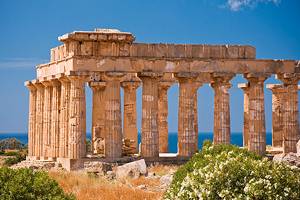
What to See near Trapani: Several interesting places, including the splendid acropolis and eight Greek temples at Selinunte, are easy day trips from Trapani. Also not far away are the attractions of Palermo and the beautiful UNESCO-acclaimed Monreale Cathedral, one of Sicily's top attractions.
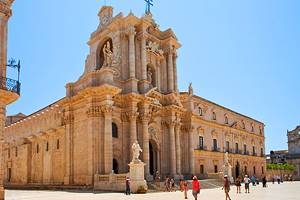
Places to Visit in Sicily: The island is filled with outstanding ancient sites. The tourist attractions of Syracuse include Greek and Roman theaters and ancient quarries. The Valley of the Temples is in Agrigento, and at Enna, the Villa Romana is famed for its spectacular mosaic floors.




